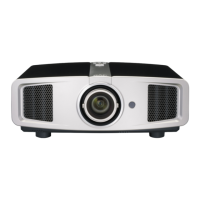uses NTSC color (REC601) for all sources.
This will result in inaccurate color for some
sources, but the color never looked
clearly”wrong” on any of the many sources I
watched.
All LCoS projectors are three-chippers—
one each for red, green, and blue. If the chips
are not aligned precisely, you’ll see misconver-
gence that can affect the sharpness of the
image. The JVC has adjustments to converge
the red, green, and blue chips, with up to seven
pixels of movement in single pixel steps in
both the horizontal and vertical directions.
This is a the first time I’ve seen this feature
in a three-chip projector, and they should all
have it. The convergence had been set reason-
ably well at the factory, though I added a sin-
gle additional step to the vertical blue channel.
This put nearly everything within one-half
pixel or less of proper alignment. Unfortu-
nately, vertical lines at the far right side of the
image were off by up to one pixel, primarily in
red. This was rarely noticeable from a normal
viewing distance, and then only as a slight red
edge to very high contrast objects on that side,
such as white titles on a black background. A
difference in pixel convergence in different parts
of the screen is generally due to chromatic aber-
ration in the lens or something else in the op-
tical path, not panel misalignment, which
would be uniform across the entire screen.
A Mask control, available only for 720p
and 1080i/p sources, masks off the image on
all sides by either 2.5% or 5%. This control
can be useful when there’s garbage on the
screen at one or more edges. Artifacts at the
edge of the screen are now fairly rare. But on
a display with little to no overscan, like the
JVC (see”Measurements”), they can be dis-
tracting when they do occur. Some displays
offer”overscan” controls that reduce image res-
olution. The JVC’s Mask control, however,
crops pixels from all sides of the image without
upscaling it to fill the screen. So you get a
slightly smaller image (unless you manually
zoom the image to fill the screen again), but
the resolution is not degraded.
The JVC will accept both 1080p/60
and 1080p/24 inputs in addition to the
other usual suspects: 480i/p, 720p, and
1080i. When I wrote the Short Take for
this projector, I did not know exactly
how the projector handled a 1080p/24
input. Now I do. According to JVC, it
quadruples the frame rate to 96fps. The
HD1’s Gennum GF9351 scaling/dein-
terlacing chip doubles the 24fps input to
48fps, the 48fps to 96fps step is added
elsewhere in the projector’s video pro-
cessing, downstream of the Gennum.
This eliminates the need for 3/2 pull-
down with 1080p/24 sources.
The only consumer sources of
1080p/24 material at present are the out-
puts of a few (not all) Blu-ray players.
Movie material on HD DVD is also na-
tive 1080p/24, but as yet no HD DV D
players will output this resolution. In-
stead, they convert it, at best, to
1080p/60, with 3/2 pulldown. (A
firmware update to Toshiba’s HD-XA2
to allow 1080p/24 output is rumored to
be imminent- Tech Ed.)
Other features include six different
built-in test patterns, a video/film mode
(Auto or Off), HDMI input level (Stan-
dard, which is the one to use, or En-
hanced), Black Level (a 0% or 7.5% offset
adjustment for the video and S-Video
inputs only), a selection to allow the
component input to accept RGB sources
or even SCART (for those in Europe),
Aspect (4:3, 16:9, or Zoom—no fancy
stretchy modes here), Menu Display
(times out the menus in five seconds or
leaves it on until you defeat it, thus low-
ering the blood pressure of calibrators
everywhere), and the ever popular Sleep
Timer.
Performance
While I’ve found some minor issues,
none of them diminish enthusiasm for
this product—an enthusiasm that has, if
anything, increased since my Short Take
report.
While the JVC isn’t quite a light can-
non, it’s definitely bright. Out of the box,
it put out just over 20 foot-Lamberts on
my 78” diagonal, 16:9 Studiotek 130
screen (white, 1.3-gain) in the Normal
lamp mode, and 25fL in High. After 200
hours, including a fresh calibration, this
decreased to a maximum of 16.3fL (Nor-
mal lamp mode) on the same screen. This
20% decrease, in my experience, is not
unusual in lamp-driven projectors. Above
this point the whites clipped, but unlike
many projectors, which tend to show
subtle discolorations in a multi-step
grayscale pattern when pushed to their
pre-clip limits (tints that often don’t reg-
ister in the grayscale measurements), the
JVC held thje pattern to a true white-
gray-black, without odd color shifts. And
at this same 200-hour mark I could still
wring 20fL out of the projector on my
screen if I switched to the High lamp
mode.
The deinterlacing and scaling of the
JVC turned in a fair performance overall.
It was good to excellent when upcon-
verting a 480i component input to the
projector’s native 1080p. But it degraded
ultimateAV

